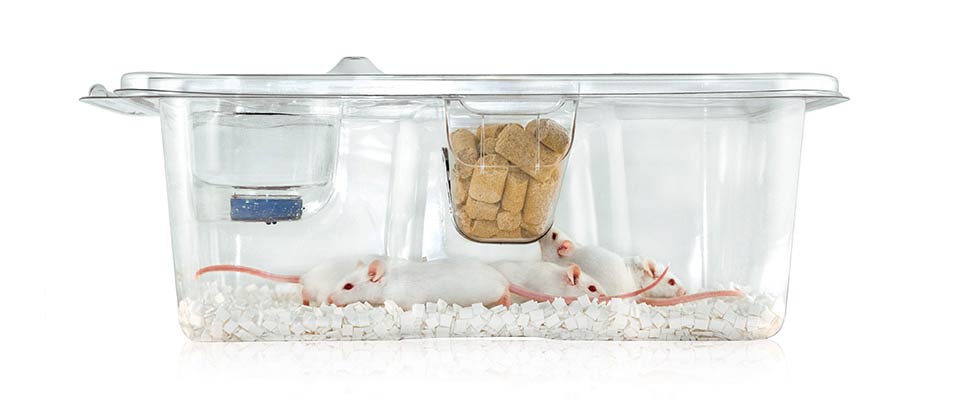Caging
- How many mice can be housed in an Innocage® Mouse?
- The Innocage® Mouse is sized for 5 mice. It provides 5 inches (12.7 cm) of headroom and over 81 in² (530 cm²) of floor space. The amount of floor space in an Innovive cage exceeds what is recommended for 5 mice in the US Guide for the Care and Use of Laboratory Animals. It also complies with the European Type II long caging specification.
- How many rats can be housed in an Innocage® Rat?
- The Innocage® Rat is sized for 2 rats. It provides 7 inches (17.8 cm) of headroom and over 140 in² (900 cm²) of floor space. The amount of floor space in an Innovive cage complies with what is recommended for 2 rats (each up to 500g in weight) in US Guide for the Care and Use of Laboratory Animals. It also complies with the European Type III caging specification.
- What is the recommended cage change interval for Innocage® IVC Mouse and Rat cages?
- For Innocage® IVC Mouse, most users perform cage changes every 14 days. Some have extended beyond 14 days when there are less than 5 mice in the cage.
For Innocage® IVC Rat, most users perform cage changes every 7-10 days. - What is the recommended cage change interval for Innocage® Static Mouse and Rat cages?
- For Innocage® Static Mouse and Rat cages, most users perform a cage change every 5-7 days. It can also be extended beyond 7 days depending on the size and number of animals in the cages.
- How much recycled plastic is used in an Innocage® bottom?
- As part of a continued effort to improve sustainable practices, Innocage® bottoms are made with up to 30% post-consumer recycled plastic. The recycled plastic is melted and thermoformed in high heat, and then the resulting Innocage bottoms are fully irradiated to ensure that it has zero bioload.
- Why do some Innocage® bottoms have a different color/hue?
- The mix of recycled plastic can slightly affect the color/hue of the Innocage® bottom, but will not affect the clarity or quality of the Innocage® bottom.
- What is the shelf life for caging supplies?
- The shelf life for caging supplies is 1 year when kept in original packaging and in good storage conditions (dry environment under 115°F/46°C).
- What is the proper temperature range for storing cages?
- The temperature for storing Innovive caging components should not exceed 115°F/46°C.
- Can the cages be autoclaved?
- Used cages can be autoclaved for decontamination purposes. Please consult with your Innovive representative for the decontamination protocol.
- Can you clean or wash the cages bottoms?
- This is not an intended use for Innovive disposable cages. Reusing cage bottoms introduces the risk of contamination.
- What does it mean when caging is “Research-Ready™”?
- Research-Ready™ means that all Innovive products arrive securely double-bagged and irradiated, and are ready for research use.
- How can I transport cages from one facility to another?
- Any standard Innovive cage can be used to transfer animals between facilities. We also offer the Innocage® Mouse Transportation lid that can be used for longer trips that span up to a week in duration.
- What type of filter paper is in your cage?
- Innovive IVC cages utilize Reemay® filter paper. Innovive static cages utilize Uniblend filter paper.
- What kind of bedding is used in the pre-bedded cages?
- We offer corn cob or ALPHA-dri® for bedding in our pre-bedded cages. We also offer corn cob bedding enriched with Innorichment™.
- How much bedding is used in each cage?
- The amount of bedding used is:
MOUSE RAT M-BTM-C8/C8E – 450 cm³
M-BTM-AD – 450 cm³R-BTM-C8 – 850 cm³
R-BTM-AD – 850 cm³ - What is the volume of the mouse feeder (M-FEED) to the fill line?
- The exact volume is 34.8in³. Volume of food will vary on packing density and size of the food pellets.
- What is the weight capacity of the mouse feeder (M-FEED) to the fill line?
- The M-FEED can hold approximately 360 grams of unautoclaved, standard pelleted rodent diet. The weight of food can vary based on factors such as the type of food pellet, ingredient composition, and environmental factors.
- How should I clean the rat wire bars?
- Your wire bars can go through a washer, an autoclave or hand wipe/sanitize as you would clean other lab supplies.

 Previous: The Innovive System Benefits
Previous: The Innovive System Benefits